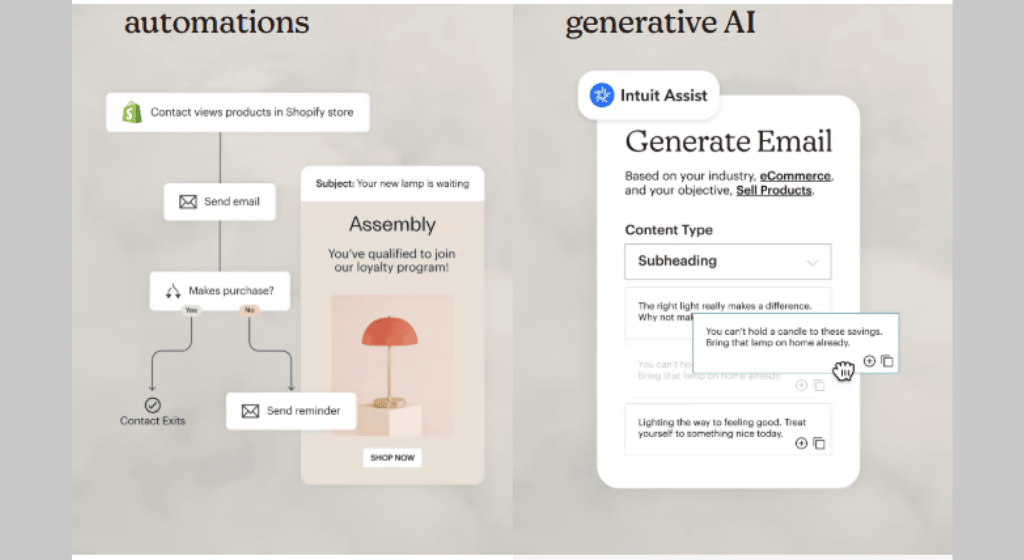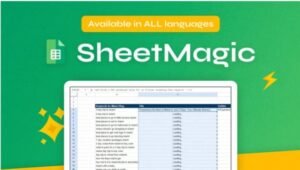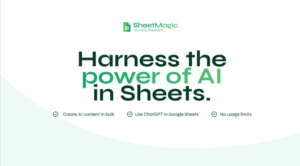Introduction
Email marketing is one of the most powerful tools in any marketer’s arsenal. With the potential for high ROI, direct engagement, and the ability to nurture leads effectively, email campaigns are here to stay. However, to get the most out of your campaigns, having the right tools at your disposal is non-negotiable. After all, no one wants to waste time manually sorting contacts or struggle with clunky interfaces that make even the simplest tasks a chore.
This article dives into the top tools for email campaigns, breaking down their features, pros, cons, and use cases. Whether you’re a small business owner or a seasoned marketer, there’s something here for everyone.
What Makes a Great Email Campaign Tool?
Features to Look For
When evaluating email marketing tools, focusing on key features is essential. The right combination of capabilities can streamline your workflow and maximize campaign effectiveness. Here’s what you should prioritize:
- User-Friendly Interface
Nobody wants to wrestle with a confusing dashboard. A great tool should be intuitive, offering drag-and-drop functionality for easy email creation and customization. - Automation Capabilities
Automation can save you hours of work. Features like scheduled email sending, drip campaigns, and automatic follow-ups are must-haves. - Analytics and Reporting
Data-driven marketing is critical for success. Tools should provide insights into open rates, click-through rates (CTR), and conversion tracking. - Integration Options
Your email tool should work seamlessly with other platforms like CRMs, e-commerce sites, and social media.
Pricing Models
Price is a significant factor when selecting the right tool. Options typically fall into these categories:
- Free vs. Premium Tools
Free tools, like Mailchimp’s basic plan, are great for beginners but may lack advanced features. - Subscription Plans and Scalability
Premium plans often come with added perks like higher subscriber limits, automation, and better support. Ensure the tool you choose scales with your business.
Deliverability Rates
Even the best-designed email won’t matter if it doesn’t reach your audience. Tools with strong deliverability ensure your emails land in inboxes instead of spam folders.
- Why It Matters: A high deliverability rate directly impacts your engagement metrics and ROI.
- Optimizing Reach: Look for tools with built-in spam testing and sender reputation management.
Top Tools for Email Campaigns
Mailchimp
Mailchimp is a favorite among marketers, thanks to its blend of ease of use and robust features.
- Overview and Features
Mailchimp offers an intuitive drag-and-drop editor, A/B testing, and detailed analytics. It integrates with numerous platforms, making it versatile for any business. - Pros and Cons
Pros:- Excellent free tier.
- Comprehensive templates.
- Good for beginners.
Cons:
- Pricing can become steep for large lists.
- Limited automation in the free plan.
- Best Use Cases
Ideal for startups and small businesses that need a reliable and user-friendly solution.
Constant Contact
Constant Contact has carved its niche as a tool focused on small to medium businesses.
- Overview and Features
This tool stands out with its event management capabilities and social media integrations. It also supports e-commerce campaigns. - Pros and Cons
Pros:- Easy learning curve.
- Great customer support.
- Strong deliverability rates.
Cons:
- Limited customization options.
- Fewer integrations compared to competitors.
- Best Use Cases
Perfect for businesses hosting events or workshops.
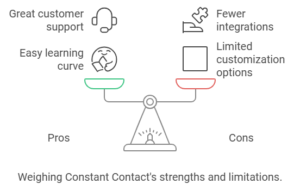
HubSpot
HubSpot is a comprehensive marketing platform that includes powerful email campaign tools.
- Overview and Features
HubSpot’s email marketing tool is part of its larger CRM and marketing suite. With drag-and-drop editors, personalized templates, and advanced segmentation options, it offers everything you need to create impactful campaigns. - Pros and Cons
Pros:- Free email marketing tools for basic users.
- Seamless integration with HubSpot’s CRM.
- Advanced automation for lead nurturing.
Cons:
- Higher-tier plans can be expensive.
- Might be overkill for small businesses without CRM needs.
- Best Use Cases
HubSpot is ideal for businesses looking to combine email marketing with broader CRM capabilities.
Sendinblue
Sendinblue has gained a reputation for its simplicity and effectiveness, especially for small to medium-sized businesses.
- Overview and Features
This tool offers email marketing, SMS marketing, and automation features in one package. Its easy-to-use interface and pay-as-you-go pricing model set it apart. - Pros and Cons
Pros:- Affordable for smaller campaigns.
- Unlimited contacts on paid plans.
- Includes SMS capabilities.
Cons:
- Limited reporting features.
- Automation can be less robust compared to competitors.
- Best Use Cases
Sendinblue is a fantastic choice for businesses focusing on email and SMS marketing.
ActiveCampaign
ActiveCampaign is known for its advanced automation capabilities, making it a favorite among seasoned marketers.
- Overview and Features
This tool emphasizes customer experience, offering features like predictive sending, robust automation workflows, and integrations with over 850 apps. - Pros and Cons
Pros:- Exceptional automation features.
- Customizable workflows.
- Great customer support.
Cons:
- Steep learning curve for beginners.
- More expensive than basic tools.
- Best Use Cases
Ideal for businesses prioritizing automation and detailed customer journeys.
Also Getrespons is one of them …
Niche Tools for Specific Campaign Needs
Drip (E-commerce-Focused Campaigns)
For e-commerce brands, Drip is a standout tool, offering tailored features to boost online sales.
- Features for Online Stores
Drip specializes in personalization, helping businesses send dynamic emails based on customer behavior and purchase history. Its integrations with platforms like Shopify and WooCommerce make it a natural choice for online stores. - Case Studies of Success
Numerous e-commerce brands have reported higher sales and engagement rates by leveraging Drip’s data-driven insights and advanced segmentation.
Campaign Monitor (Advanced Customization)
If aesthetics and brand consistency are your priorities, Campaign Monitor delivers unparalleled design flexibility.
- Visual Design Capabilities
The tool offers a robust template builder with drag-and-drop functionality, enabling designers to create stunning email campaigns that align with their brand identity. - Benefits for Designers
It’s perfect for businesses that want visually engaging emails without sacrificing functionality.
Moosend (Budget-Friendly Solution)
Moosend is a hidden gem for businesses seeking value-packed email marketing on a budget.
- Low-Cost Features with Great Value
Despite its lower price point, Moosend offers advanced automation, analytics, and A/B testing. - Drawbacks for Enterprise Needs
It may lack the scalability and advanced features required by large corporations, but for smaller campaigns, it’s more than sufficient.
Factors to Consider When Choosing an Email Campaign Tool
Your Business Size and Needs
Different tools cater to different scales of business operations.
- Startups: Look for affordable tools with basic features.
- Enterprises: Opt for tools with advanced analytics and integration capabilities.
Ease of Use
Your team’s technical expertise will influence the best choice.
- Tools like Mailchimp are beginner-friendly.
- Advanced tools like ActiveCampaign may require more training.
Scalability
As your business grows, your email marketing needs will evolve. Choose a tool that can handle increased contacts, advanced automation, and higher email volumes.
Security and Privacy
Email marketing involves handling sensitive customer data. Ensure the tool you select complies with GDPR and other data protection laws.
Tips for Effective Email Campaigns
Crafting Engaging Content
Content is king in email marketing, and the right message can make or break your campaign.
- Headlines and Subject Lines
The subject line is your first impression—make it count! Use attention-grabbing language, personalization, and urgency to entice your audience to open the email.
Example: Instead of “Our New Collection is Here”, try “Your New Favorite Outfit is Waiting—Shop Now!” - Personalization
Personalization goes beyond using a recipient’s name. Incorporate dynamic content based on user behavior, like purchase history or browsing activity. For example, recommend products based on previous purchases.
Timing and Frequency
The timing and frequency of your emails significantly impact engagement.
- Optimal Sending Times
Research suggests the best days for email marketing are Tuesday and Thursday, while optimal times are mid-morning or early afternoon. - Avoiding Spam Filters
Send emails at a consistent frequency to avoid appearing spammy. Overloading your subscribers’ inboxes is a surefire way to lose their interest.
Testing and Optimization
Continuous improvement is key to maximizing the success of your campaigns.
- A/B Testing
Test different subject lines, layouts, and call-to-action (CTA) placements to see what resonates with your audience. - Using Feedback for Better Performance
Use data from analytics tools to refine future campaigns. If open rates are low, rethink your subject lines. If CTRs are underwhelming, work on your CTAs.
Tips for Effective Email Campaigns
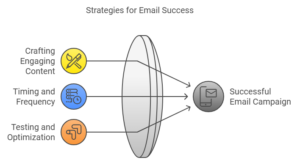
Comparison Table of Email Campaign Tools
| Tool | Key Features | Pricing | Best For |
|---|---|---|---|
| Mailchimp | Drag-and-drop editor, analytics, automation | Free to $299/month | Small businesses, startups |
| Constant Contact | Event management, integrations, deliverability | $9.99 to $45/month | Event-driven businesses |
| HubSpot | CRM integration, advanced segmentation | Free to $890/month | Enterprises, CRM users |
| Sendinblue | SMS marketing, pay-as-you-go pricing | Free to $65/month | SMBs with multichannel needs |
| ActiveCampaign | Advanced automation, predictive sending | $29 to $479/month | Automation-heavy campaigns |
| Drip | Behavioral emails, e-commerce integrations | $39 to $1,599/month | Online retailers |
| Campaign Monitor | Customizable designs, easy reporting | $9 to $149/month | Visually engaging campaigns |
| Moosend | Budget-friendly, A/B testing | $9 to $670/month | Cost-conscious users |
Conclusion
Email marketing remains a vital tool in digital strategies, but its success depends on choosing the right platform. Whether you’re just starting or managing enterprise-level campaigns, selecting a tool that aligns with your needs can save time, boost engagement, and enhance ROI. From Mailchimp’s user-friendly interface to ActiveCampaign’s automation, there’s an ideal solution for everyone.
Experiment with the features of these tools, analyze your performance, and continuously refine your campaigns to achieve the best results. A great email marketing tool isn’t just a software purchase—it’s an investment in your business’s growth.
FAQs
- What is the best free email marketing tool?
Mailchimp and HubSpot offer excellent free plans with essential features for startups and small businesses. - How do email campaign tools improve ROI?
They streamline workflows, enhance personalization, and provide analytics to optimize campaigns, resulting in better engagement and conversions. - Are email campaign tools suitable for small businesses?
Absolutely. Tools like Sendinblue and Moosend are budget-friendly yet powerful enough for small businesses. - How can I ensure my emails don’t land in spam?
Use a verified domain, personalize content, avoid spammy keywords, and maintain a consistent sending schedule. - Can I manage multiple campaigns using one tool?
Yes, most tools like ActiveCampaign and HubSpot support managing multiple campaigns through segmentation and automation.

